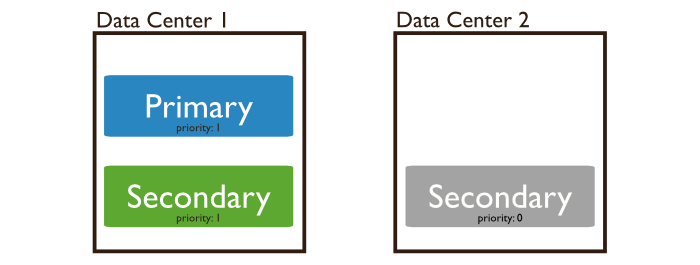- Replication >
- Replication Concepts >
- Replica Set Members >
- Replica Set Secondary Members >
- Priority 0 Replica Set Members
Priority 0 Replica Set Members¶
A priority 0 member is a secondary that cannot become primary. Priority 0 members cannot trigger elections. Otherwise these members function as normal secondaries. A priority 0 member maintains a copy of the data set, accepts read operations, and votes in elections. Configure a priority 0 member to prevent secondaries from becoming primary, which is particularly useful in multi-data center deployments.
In a three-member replica set, in one data center hosts the primary and a secondary. A second data center hosts one priority 0 member that cannot become primary.

Priority 0 Members as Standbys¶
A priority 0 member can function as a standby. In some replica sets, it might not be possible to add a new member in a reasonable amount of time. A standby member keeps a current copy of the data to be able to replace an unavailable member.
In many cases, you need not set standby to priority 0. However, in sets with varied hardware or geographic distribution, a priority 0 standby ensures that only qualified members become primary.
A priority 0 standby may also be valuable for some members of a set with different hardware or workload profiles. In these cases, deploy a member with priority 0 so it can’t become primary. Also consider using an hidden member for this purpose.
If your set already has seven voting members, also configure the member as non-voting.
Priority 0 Members and Failover¶
When configuring a priority 0 member, consider potential failover patterns, including all possible network partitions. Always ensure that your main data center contains both a quorum of voting members and contains members that are eligible to be primary.
Configuration¶
To configure a priority 0 member, see Prevent Secondary from Becoming Primary.
Thank you for your feedback!
We're sorry! You can Report a Problem to help us improve this page.
